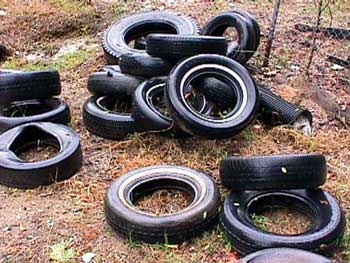![[Metroactive Features]](http://metroactive.com/features/gifs/feat468.gif)
[ Features Index | Silicon Valley | Metroactive Home | Archives ]
Rev
Tire Story
Like little worms, tires buried underneath yards and yards of debris naturally migrate toward the top of the pile
By Novella Carpenter
IN AN ACT of pure torture, I spent a gorgeous, sunny Saturday at a Tire Amnesty Day. Even the garbage guys manning the tire drop-off were laughing at me. They were getting paid time and a half, and me, well, I'd eventually get paid something—right? The scene was what you'd expect: a big parking lot with cones directing cars toward the big trucks and garbage guys—Jim, Paul, and Jose—who tossed 30-pound tires like they were donuts. As you can imagine, the people dropping off tires were extremely pleased to get rid of their rubber albatrosses.
Cities across the country hold events like this tire-amnesty day because tires are a major health concern. Rainwater accumulates in tire piles (or even just one tire), which are warmed by the sun and then become prime breeding grounds for mosquitoes, which in turn are vectors for the dreaded West Nile virus. Tires also have the nasty tendency to catch fire. And when tires burn, they burn long and dirty.
So, please, car junk collectors: don't stockpile tires! Most tire stores take the old tires when you buy replacements—take them up on it. According to my new (but old) favorite book, Rubbish! What Trash Says About Our Society, most states don't allow people to put whole tires in the trash, because they have the particular ability to drift toward the top of a landfill. Like little worms, tires buried underneath yards and yards of debris naturally migrate toward the top of the pile. This migration ruins the "structure" of a landfill, and so now they are mostly shredded upon arrival after events like the tire day.
The woman in charge of the event informed me the tires received would be taken to the dump, shredded and then shaped into next generation AstroTurf used on various sports fields, rubber sidewalks and playgrounds. It struck me as unlikely that all 245 million tires thrown away each year in America could be reused in this way—that's a lot of playgrounds.
Sadly, after an interview with a trash expert, I found out that my hunch was right. The vast majority of used tires are either burned as fuel for industrial processes or they are shredded and spread on top of landfills as something called alternate daily cover (ADC). Bummer. I'm not dissing Tire Amnesty Day: It is a great health benefit to get tires out of backyards to stop an outbreak of West Nile virus and prevent fires. But, in general, tires just suck. Burning tires for fuel seems wildly unhealthy, and putting them on top of the landfill as ADC is still putting tires in the landfill.
Take this column, then, as a call to awareness. We almost all have cars or bikes that use tires that are ultimately not a sustainable product. However, to assuage your guilt and make a small difference, you can do something to make them last longer.
The first thing you should do is buy tires that last longer—they might be slightly more expensive, but well worth it. Check the ratings stamped on the sidewall to find tires that will last the longest. You should also check the tire pressure regularly and keep them properly inflated. By rotating your tires every 6,000 miles, you can extend tire life by preventing uneven wear.
Also, you can look for new products that might alleviate the vicious tire cycle. One is the nonpneumatic Tweel, introduced by Michelin early this year. The Tweel is a one-piece airless tire/wheel. You have to see it to believe it. It looks like a wagon wheel with just a thin layer of rubber that bends when it hits an object, then springs back into shape. Michelin scientists report that it will last two to three times longer than a standard wheel. Also, the Tweel can be retreaded instead of replaced. So far the Tweel isn't available for passenger cars, but Michelin hopes to release them in a few years.
As always, I support people seeking out retreaded tires, too. They are available for light trucks and commercial vehicles. But if enough people call for them in passenger cars, they will become available—ask your local distributor!
[ Silicon Valley | Metroactive Home | Archives ]
Copyright © 2005 Metro Publishing Inc. Metroactive is affiliated with the Boulevards Network.
For more information about the San Jose/Silicon Valley area, visit sanjose.com.
![]()

Send a letter to the editor about this story to letters@metronews.com.
From the October 5-11, 2005 issue of Metro, Silicon Valley's Weekly Newspaper.